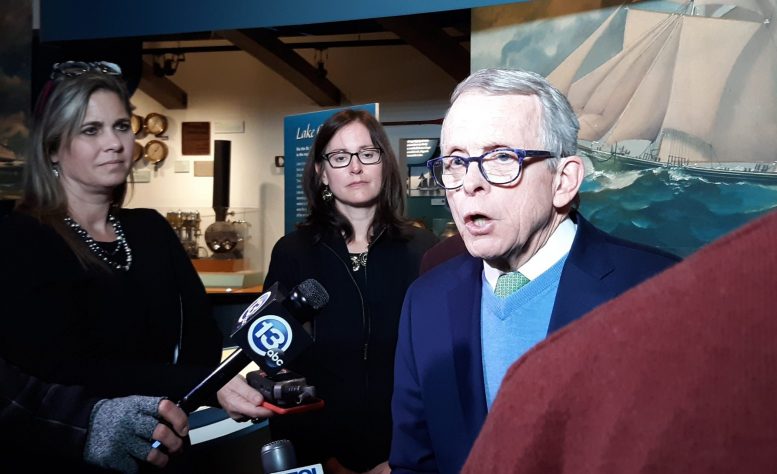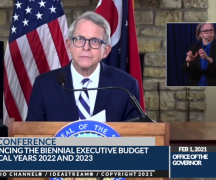Ohio Gov. Mike DeWine has resolutely refused to condemn President Donald Trump’s controversial words and actions — including some that have undermined DeWine’s own efforts to get people to protect themselves and others against coronavirus.
On Thursday, the governor seemed to say that Trump’s nominations of conservative judges and his economic policies justify all the other things about the president that DeWine won’t talk about.
“Everybody I’ve voted for for president, there’s some things I might not have agreed with them on,” DeWine said in a Zoom press conference with reporters. “Everyone has to make a choice. I’ve spelled out very clearly some of the things I think Donald Trump has done exceedingly well.”
Since DeWine began holding regular press conferences as the coronavirus pandemic took hold in March, he’s steered clear of directly criticizing a president famous for going after members of his party who question him.
To be fair, for the better part of a year the governor has been between a political rock and a hard place. His mostly unenforced requirements for mask use and mostly expired restrictions on business activities have earned him a torrent of Twitter abuse, with some calling him a fascist and blaming him for destroying Ohio.
But Trump’s words and deeds have complicated DeWine’s task as he’s tried to position himself as a responsible leader who has the best interests of all Ohioans at heart.
Last week, he criticized a presidential debate in which Trump was widely criticized for, among other things, repeatedly talking over former Vice President Joe Biden. But the criticisms were carefully aimed at both candidates on the debate stage.
DeWine also declined to criticize Trump’s continued refusal to say he’d accept the results of the election or the president’s refusal in the debate to condemn a far-right group that supports Trump and promotes violence. In general terms, DeWine said violence and disrupting elections were wrong, but he passed — twice — when asked if he believed Trump’s statements were wrong.
“Press conference after press conference, I get asked about different comments made by the president or somebody else,” Trump’s Ohio co-chair said. “I’m not here to answer every single thing the president says.”
On Thursday, DeWine was asked if he was trying to have it both ways: praising those of Trump’s statements and actions he supported, but trying to stay mum on those that had stirred the most extreme controversy.
After saying he’s never completely agreed with anybody he’d voted for, DeWine listed the things Trump has done that he does agree with.
“I’m very happy with who Donald Trump has put on the courts,” DeWine said. “He made a commitment to people in Ohio and the country, to many people who voted for him the first time, he’s kept that commitment. He’s put people who believe in the Constitution, who know they’re not legislators, very qualified individuals… His last Supreme Court nominee (Amy Coney) Barrett certainly fits that as well.”
DeWine also praised Trump for what he called “tough” economic negotiations.
Then the governor went about as far as he has in criticizing the president. Referring to his constant urging for Ohioans to wear masks and all the heat he’s taken for it, DeWine said, “Donald Trump has not taken those same positions, obviously. He and I don’t agree on some of those things. Those things I think are obvious.
“But I think like every American, in the end, I’m voting for one of two people and I’m very happy to be voting for Donald Trump for the reasons that I said.”
THE MORNING NEWSLETTER Subscribe now
***
Also from Ohio Capital Journal:
List maintenance or voter purges: How the practice of maintaining voter lists became so polarized

In the last decade, millions of registered voters across the country have been removed from voter rolls.
In 2019, Ohio removed more than 460,000 voter registration files from its list. Georgia removed 313,000 people from its rolls in October 2019 alone, and in Michigan, from 2011 to 2018, 1.2 million voters were removed from voter lists.
This practice, known as list maintenance, is required by a federal law — the National Voter Registration Act (NVRA).
Some of those removals came after voters moved or died. It’s in the best interest of states to keep their lists up-to-date because it saves time and money, preventing poll workers from sifting through a long and inaccurate list. It’s in the best interest of voters because if elections administrators know where you should be registered to vote, they can send accurate information about what is on the ballot.
“What’s often lost in list maintenance, it’s often an enfranchising practice,” says David Becker, executive director of the Center for Election Innovation and Research. “If you’re updating voter lists and trying to identify people who have moved in the state and find them at a new address, you’re enfranchising those people.” READ MORE
A plot to kidnap Michigan’s governor was planned in a ritzy Columbus suburb, prosecutors say
This summer, a cabal of a least 15 extremists meeting in Dublin, Ohio began crafting a violent plan to “storm” the Michigan state Capitol and kidnap Gov. Gretchen Whitmer, law enforcement officials say.
Six men were federally charged with conspiring to kidnap Whitmer, and another seven were charged with violations of Michigan’s anti-terrorism laws connected to alleged involvement with the “Wolverine Watchmen” militia group.
The federal allegation, unsealed Thursday morning, details plans of armed assaults on the Michigan State Police, construction of improvised explosive devices, covert meetings held in a Grand Rapids basement accessible by secret trap door, nighttime surveillance of Whitmer’s home, and quasi-military “field training exercises” to prepare for an abduction sometime before the November elections.
“When the time comes, there will be no need to try and strike fear through presence,” Brandon Caserta said Sept. 17, according to prosecutors, opting against attending an armed protest at the State Capitol. “The fear will be manifested through bullets.” READ MORE
Trump and McConnell’s mostly white male judges buck 30-year trend of increasing diversity
In nominating Amy Coney Barrett to replace the late justice Ruth Bader Ginsburg, President Donald Trump fulfilled his pledge to put another woman on the U.S. Supreme Court.
But most of the 218 judges Trump has so far appointed to the federal judiciary – with the steadfast collaboration of Senate Majority Leader Mitch McConnell – are not women or judges of color.
Our study on judicial diversity, which ended in July 2020, shows that Trump-appointed judges are 85% white and 76% men – the least diverse group of federal judges seen since Ronald Reagan.
This bucks a 30-year historical trend of increasing diversity on the bench, our research shows. Using data from the Federal Judicial Center, we collected demographic information on all lower court judges and their predecessors dating back to the Carter administration.
Trump’s appointments have made the federal judiciary less diverse. And our research as scholars of judicial politics suggests that could erode the legitimacy of the judicial system. READ MORE





